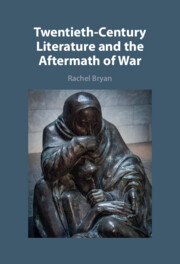Book contents
- Twentieth-Century Literature and the Aftermath of War
- Twentieth-Century Literature and the Aftermath of War
- Copyright page
- Dedication
- Epigraph
- Contents
- Acknowledgements
- Abbreviations
- Introduction
- Chapter 1 Untimely Deaths and Artful Promise in Henry James’s Post-1890 Writings
- Chapter 2 Reading Henry James in First World Wartime
- Chapter 3 Imaginary Widowhood in Elizabeth Bowen’s ‘A Year I Remember – 1918’ and A World of Love
- Chapter 4 Retroactive Judgements in Elizabeth Bowen’s The Heat of the Day
- Chapter 5 Traitors, Treason, and ‘Topsy-Turvy’ Values in Kazuo Ishiguro’s ‘The Summer After the War’ and An Artist of the Floating World
- Chapter 6 Art and Consolation in Kazuo Ishiguro’s Never Let Me Go
- Index
Chapter 1 - Untimely Deaths and Artful Promise in Henry James’s Post-1890 Writings
Published online by Cambridge University Press: 20 December 2024
- Twentieth-Century Literature and the Aftermath of War
- Twentieth-Century Literature and the Aftermath of War
- Copyright page
- Dedication
- Epigraph
- Contents
- Acknowledgements
- Abbreviations
- Introduction
- Chapter 1 Untimely Deaths and Artful Promise in Henry James’s Post-1890 Writings
- Chapter 2 Reading Henry James in First World Wartime
- Chapter 3 Imaginary Widowhood in Elizabeth Bowen’s ‘A Year I Remember – 1918’ and A World of Love
- Chapter 4 Retroactive Judgements in Elizabeth Bowen’s The Heat of the Day
- Chapter 5 Traitors, Treason, and ‘Topsy-Turvy’ Values in Kazuo Ishiguro’s ‘The Summer After the War’ and An Artist of the Floating World
- Chapter 6 Art and Consolation in Kazuo Ishiguro’s Never Let Me Go
- Index
Summary
This chapter focuses on examples of Henry James’s post-1890 writings – including Notes of a Son and Brother (1914), the Prefaces to the New York Edition (1907–9), and ‘Maud-Evelyn’ (1900) – which engage with, or themselves embody, the challenge of commemorating lives cut short prematurely or traumatically. The first half addresses formal and stylistic features and explores how James’s commitment to conserving and commemorating the unspent experiential potential of the dead of the American Civil War manifests within his late aesthetics: informing syntax, notions of character, and the pressure placed on traditional narrative structures. The subsequent sections then trace a competing phenomenon, inspired in part by the author’s meditations on Civil War Monuments: the concern that several of James’s late works (both fictional and non-fictional) display about the wisdom of investing emotionally in the unlived lives of the untimely dead. Together, these sections argue that, during the last twenty-five years of his life, James produced writings at once enthralled by and wary of unfulfilled narrative potential, and attentive to how it might be used to bind epochs together.
Keywords
- Type
- Chapter
- Information
- Twentieth-Century Literature and the Aftermath of War , pp. 37 - 78Publisher: Cambridge University PressPrint publication year: 2025

